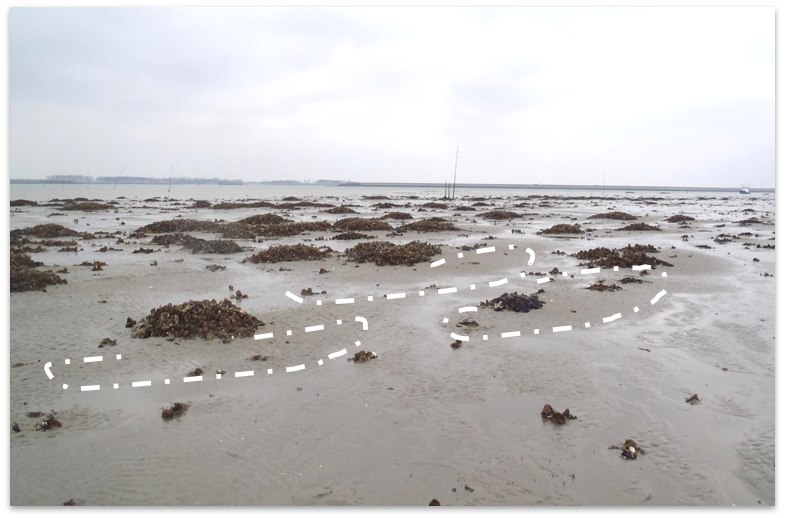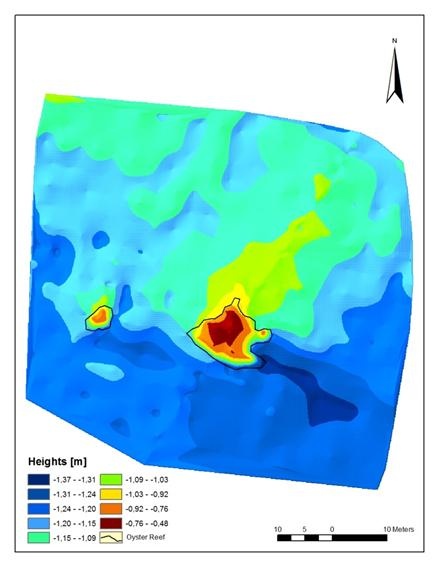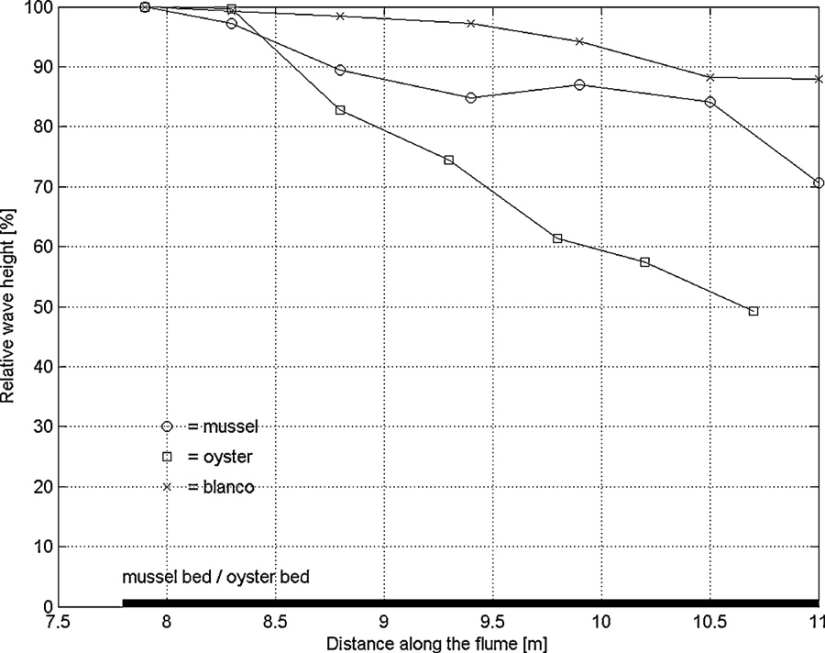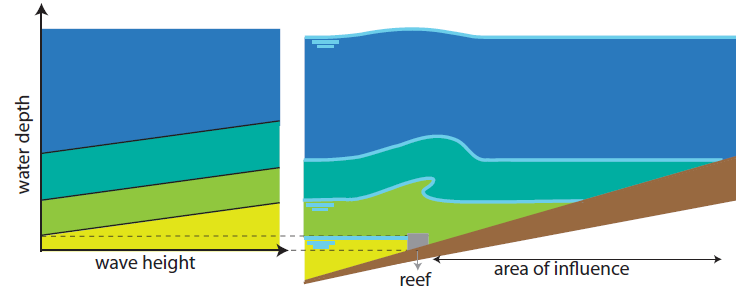Planning and design
The Building with Nature program established that oyster reefs can be used in coastal protection under three conditions:
- Availability of substrate for oyster larvae settlement;
- Environmental conditions that enable the survival and growth of oysters;
- Evidence that oyster reefs do protect the shoreline and the intertidal habitats at the location considered.
Phase 1: WINN “Biobouwers” project 2006 – 2008
The WINN Biobouwers project, the precursor of this Building with Nature project, applied loose oyster shells as a substrate for artificial reefs. In the course of the project it became clear that such reefs are unstable and yield oyster shell densities primarily determined by flow direction and intensity. After a severe winter storm, nearly all oysters in the area had been dislodged, leaving the tidal flat nearly empty of oysters, except from a nearby oyster reef that had established naturally.
At the end of the two-year project, all oysters had either been buried or washed out of the area. Several additional experiments were performed to test methods to improve the resilience of the reefs to physical pressures and to enhance the settlement of oyster larvae. These experiments showed that oysters were mainly dislodged under stormy conditions with relatively high flow velocities. A further habitat analysis showed significant relationships between the natural occurrence of oyster reefs and bottom shear stress and exposure time. These findings were used to produce a habitat suitability map based on bottom shear stress and water depth.
The WINN biobouwers project led to the conclusion that self-reliant oyster reefs can establish if a suitable substrate enables the settlement of oyster larvae and oyster growth. Therefore, the sequel of this project, in the framework of Building with Nature, paid special attention to habitat suitability and the type of substrate used. Factors that may limit oyster presence were identified, as they help finding locations where oyster reefs can be used for shore and shoal protection.
Phase 2: Building with Nature 2008-2012
Availability of substrate for oyster larvae settlement
After fertilization, oyster eggs evolve in oyster larvae which live a planktonic life in the water column before settlement. In order to grow into adult oysters they must settle on a hard substrate. Which substrate is best depends on local conditions, such as waves, currents and sediment dynamics. At sheltered sites, most (natural and artificial) hard substrates, ropes or even plant materials can create the necessary substrate for settlement (Brumbaugh and Coen, 2009). Examples are shells, cement “reef balls”, crushed concrete and other waste materials. Most artificial reefs are built using oyster shells, as these attract larvae and yield high settlement, survival and growth rates of oyster larvae (Nestlerode, Luckenbach et al., 2007). Dutch oyster farmers successfully catch oyster larvae on loose lying mussel shells in sheltered areas with low sediment deposition rates. In such areas, fixing the substrate can enhance oyster settlement and survival, but this is expensive and maybe unnecessary if sufficient substrate is provided (Brumbaugh and Coen, 2009). In contrast, it is impossible to use loose substrates at exposed sites like the North sea coast. Currents, wave action and sediment displacements will toss and turn or smother them, thus hampering oyster settlement and survival. Lenihan (1999) also found that flow velocity and wave action determine the delivery and settlement of oyster larvae.
Means to fix the substrate are baskets, nets, concrete, Biogrout blocks, gabions, etc. During the Building with Nature program we tested different ways to fix oyster and mussel shells in the Eastern Scheldt. As we aimed for the substrate of oyster shells to become a live and natural reef after some time, we used degradable structures to fix the shells. We choose three potential substrates: Biogrout blocks, which are composed of sand that is calcified by bacteria, chicken wire cages and the stronger gabions (Dutch: schanskorven). Gabions are large metal frames, usually filled with rock in order to create a larger construction element. Oyster shells in gabions proved to be the best combination to catch oyster larvae as the gabions were strong and able to fixate the larger oyster shells. The combination between cages and mussel shells was unsuitable as the chicken wire was too weak and flexible and mussels were lost from or moved within the cages. The Biogrout blocks tested in these experiments disintegrated within a few tides.
Environmental conditions that enable the survival and growth of oysters
Oyster reefs can be persistent if the environmental conditions favour 1) settlement of oyster larvae, 2) their survival and 3) the growth of adults. Oyster reefs are therefore best installed at sites where oyster reefs can naturally occur. However, this does not mean that the application of artificial oyster reefs is restricted to those areas. In soft sediment habitats oysters may be absent by lack of hard substrate, which makes it impossible for them to settle. The provision of a hard substrate eliminates this bottleneck to larvae settlement. In the Netherlands, existence of oyster reefs is often induced by the introduction of hard substrate, such as waste materials and artificial coastal defense structures.
Yet, substrate is not always the limiting factor in oyster growth and survival. Whether absence of hard substrate is the reason for the absence of oysters is best tested on site and should be based on knowledge of the population dynamics of the ecosystem engineer considered. Not only a suitable substrate for settlement, but also temperature, salinity, acidity, water quality, currents, predation and food availability determine oyster survival and growth. In the intertidal area, all these factors vary strongly during the tide. Hence exposure time is one of the determining factors for survival and growth of oysters (Schellekens, Wijsman et al. 2011). Experiments in the Eastern Scheldt revealed an optimal position of oyster reefs low in the intertidal. Oyster larvae there settle most and grow best at some 60 cm below the mid intertidal (Walles et al., unpublished). The survival of oysters is also strongly influenced by sediment dynamics: if too much sediment settles on the reefs, oysters will get smothered and die.
Evidence that oyster reefs do protect shorelines and intertidal habitats
Clearly, oyster reefs cannot replace primary flood defense systems such as dikes or dams. Placed in the right position, however, oyster reefs can reduce wave height and tidal currents leading to a net deposition of sediment under average weather conditions. This will reduce erosion and create a wave-attenuating barrier in front of the primary coastal defense.
The latter is shown in three different ways. Firstly, observations in the field clearly show that oyster clutches can increase sediment deposition, as illustrated by the photo to the right of oyster clutches in the Eastern Scheldt. The white lines indicate sheltered areas behind the clutches sediment deposition rates are higher (or erosion rates lower). A depth analysis around an oyster clutch in the Eastern Scheldt revealed similar patterns at a larger scale. The shallow area behind the oyster reef (extending to the north-east) clearly shows that oyster reefs can increase sediment deposition or reduce erosion (Walles et al., unpublished).
Secondly, a flume study (see figure, showing the relative wave height in a flume with sandy sediment, mussels and oysters) revealed that oyster reefs can reduce wave height, in this experiment by approximately 40% (Borsje, van Wesenbeeck et al., 2011).
Thirdly, a simple wave model can be used to determine the conditions under which oysters reefs are capable of reducing wave height. Inputs are the slope of the tidal flat, the height of the reef, the incoming wave height and the water level (TUD, Bram van Prooijen). The Area of influence figure shows the following color indications:
- yellow zone: waves are already broken in front of the reef, due to limited water depth;
- green zone: waves break on the reef, giving the strongest reduction of wave height;
- turquoise zone: waves do not break, but are dissipated by the reef;
- blue zone: no influence of reef, water depth too large compared to wave height & reef height.
During high tide or in case of a high water level set-up the effect of the reef may be minimal, whereas it may be significant during low tide.
Legislation
The construction of artificial oyster reefs in the Eastern Scheldt requires a legal permit. As the basin is a national park and a protected area under Natura 2000, local authorities had to verify whether the deployment of oyster reefs would threaten the conservation goals of the area. This was done with an appropriate assessment, a formal procedure that assesses the effects of a proposed activity on any of the conservation goals of the area. Based on the appropriate assessment for the deployment of oyster reefs in the Eastern Scheldt, local authorities granted a preliminary legal permit. Stakeholders were given a few months’ time to object against the plan, but nobody did so and the licence was granted. Nonetheless, local oyster farmers did raise their concern about larger-scale application of artificial oyster reefs for shore and shoal protection, as this might exceed the carrying capacity for shellfish in the area.
Governance
Governance issues that where important in the Planning and Design phase:
- The discussion on the role of the Pacific Oyster (Ostrea gigas) in the Eastern Scheldt. Some consider the Pacific Oyster as an invasive exotic that should not be allowed to expand. Additionally, many mussel farmers fear that the Pacific oyster, with its high filter capacity, will put a strain on the (already limited) amount of food (phytoplankton) available in the Eastern Scheldt. On the other hand, the Pacific Oyster can also be claimed to fill the empty space left by the Dutch Oyster (which has been decimated by a disease) and to provide habitat to a diverse species community. The presence of the Pacific Oyster is therefore related to protected nature values in the Eastern Scheldt area. Either way, at present there are no regulations with respect to the occurrence of the Pacific Oyster in the Eastern Scheldt.
Future application
The concept of shellfish reefs will also be used in the project Soft Sand Nourishment Oesterdam. This project involves the realization of an innovative safety buffer along the Oesterdam, a dam in the Eastern Scheldt. Sand nourishment within the area should realize a safety buffer to ensure flood safety and nature development all in one.




